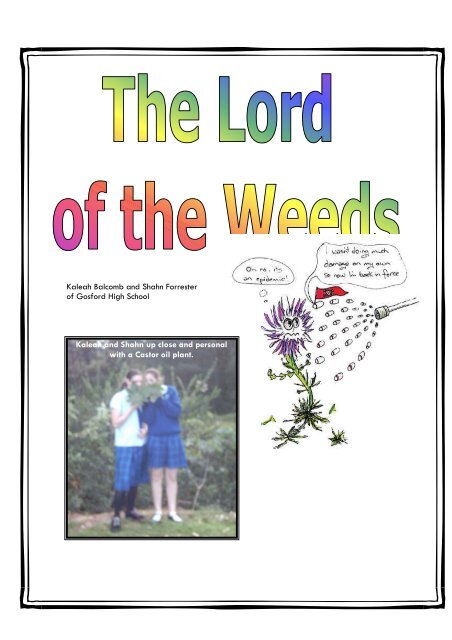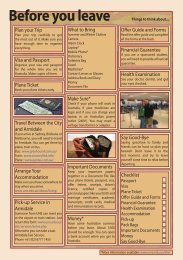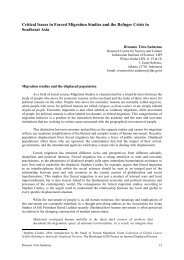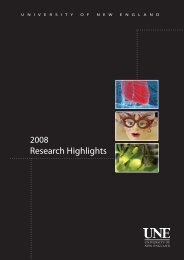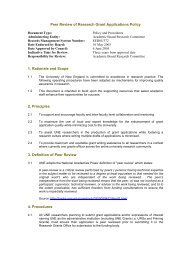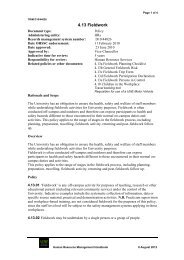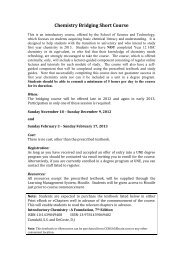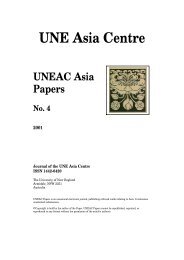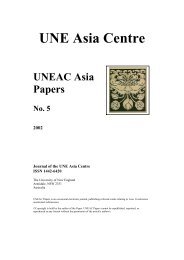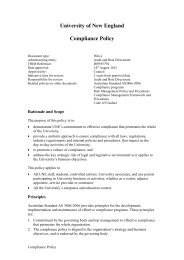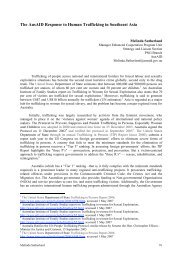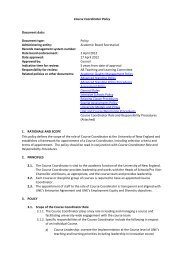Kaleah Balcomb and Shahn Forrester of Gosford High School ...
Kaleah Balcomb and Shahn Forrester of Gosford High School ...
Kaleah Balcomb and Shahn Forrester of Gosford High School ...
Create successful ePaper yourself
Turn your PDF publications into a flip-book with our unique Google optimized e-Paper software.
<strong>Kaleah</strong> <strong>Balcomb</strong> <strong>and</strong> <strong>Shahn</strong> <strong>Forrester</strong><br />
<strong>of</strong> <strong>Gosford</strong> <strong>High</strong> <strong>School</strong><br />
<strong>Kaleah</strong> <strong>and</strong> <strong>Shahn</strong> up close <strong>and</strong> personal<br />
with a Castor oil plant.
Our stretch <strong>of</strong><br />
weeds (approx. 100m),<br />
with the school <strong>of</strong>f to<br />
the right.<br />
Our school is located on the corner <strong>of</strong><br />
Showground Rd <strong>and</strong> Racecourse Rd in<br />
<strong>Gosford</strong> on the Central Coast, NSW. Our<br />
chosen area is situated along the side <strong>of</strong> the<br />
school’s sports oval (diagram below). As<br />
students we would like to take pride in the<br />
appearance <strong>of</strong> our school, but unfortunately<br />
the area has been neglected, which has<br />
resulted in an unsightly weed problem. The<br />
thin expanse <strong>of</strong> weeds looks completely out<br />
<strong>of</strong> place, considering the rest <strong>of</strong> our school is<br />
relatively tidy. In the rare occasion <strong>of</strong> rain,<br />
the small ditch becomes a drain <strong>of</strong> sorts,<br />
though as our weeds have grown this is<br />
slowly being choked up.<br />
One option, after the weeds have been eradicated, is to plant native water plants in the<br />
drain, <strong>and</strong> install seats along the stretch <strong>of</strong> grass. This would prove a nice place to sit at breaks,<br />
being in the shade for the majority <strong>of</strong> the day, <strong>and</strong> would also be useful for when sports matches<br />
are being conducted on the grounds.<br />
A multitude <strong>of</strong> weeds have been found along this section <strong>of</strong> our oval. Disturbingly, the<br />
majority <strong>of</strong> these are noxious for humans <strong>and</strong> animals, <strong>and</strong> take over areas otherwise occupied by<br />
native species. The main weeds <strong>of</strong> concern<br />
are Broad-leaf privet (Ligustrum lucidum),<br />
Narrow-leaf privet (Ligustrum sinense),<br />
Green cestrum (Cestrum parqui) <strong>and</strong><br />
Lantana (Lantana camara), though we have<br />
also found Wild tobacco bush (Solanum<br />
mauritianum), Mulberry (Morus alba), Scotch<br />
thistle (Onopordum acanthium), <strong>and</strong><br />
Castor oil plant (Ricinus communis) in areas.<br />
If left alone, these species would continue to<br />
exp<strong>and</strong>, encroaching on our oval <strong>and</strong><br />
becoming much more inconvenient. By<br />
replacing these weeds with natural<br />
alternatives, the area would be much more<br />
pleasing to view <strong>and</strong> would not have so<br />
much <strong>of</strong> a cluttered feel.<br />
Investigating up<br />
close.<br />
A weed is a plant that has the potential to degrade l<strong>and</strong> <strong>and</strong> biological diversity, thus having a<br />
detrimental effect on economic, conservation or social values. Or simply a plant out <strong>of</strong> place.
<strong>Gosford</strong><br />
<strong>High</strong><br />
<strong>School</strong><br />
Buildings<br />
Our chosen area in relation to <strong>Gosford</strong> <strong>High</strong> <strong>School</strong>.<br />
N<br />
Weedy Area<br />
<strong>School</strong> Oval<br />
Pr<strong>of</strong>ile <strong>of</strong> the area looking North<br />
d<br />
r<br />
a<br />
i<br />
n
Ligustrum lucidum <strong>and</strong> Ligustrum sinense<br />
There are forty to fifty different species <strong>of</strong> privets that are native to Europe <strong>and</strong> Asia, <strong>and</strong> two <strong>of</strong><br />
these, commonly known as narrow-leaf privet <strong>and</strong> broad-leaf privet, have become a major<br />
concern in Australia. Abundant sightings <strong>of</strong> both these noxious weeds occurred in our area,<br />
therefore counting them as plants not to be ignored.<br />
Ligustrum lucidum<br />
Common names: Broad-leaf privet, Tree privet, Glossy privet, Privet<br />
(large leaf), Chinese white-wax tree<br />
Family: Oleaceae<br />
Origin: China <strong>and</strong> Japan<br />
Ligustrum lucidum is still regularly seen in ornamental gardens<br />
throughout southeast Queensl<strong>and</strong>. A robust, vigorous, fast growing<br />
plant, it likes to grow in moist, nutrient rich sites such as creeks <strong>and</strong> gullies. With a maximum height<br />
<strong>of</strong> around 10m, the evergreen has closely packed branches, <strong>and</strong> as a young plant grows<br />
aggressively resulting in the possible displacement <strong>of</strong> native understorey.<br />
The oval leaves have pointed tips, are 12-13cm long <strong>and</strong> 5-6cm wide. They are a glossy<br />
dark green colour, pale <strong>and</strong> dull underneath. Their texture is leathery, <strong>and</strong> the leaves have a<br />
smooth margin <strong>and</strong> are placed in opposite pairs around the stem. Lenticels (small brown bumps)<br />
can also be identified on the stem.<br />
Heavily scented terminal panicles <strong>of</strong> white flowers occur in summer (mainly January to<br />
March) are highly allergenic, <strong>and</strong> grow to<br />
approximately 0.5cm long. They are<br />
Large-leaf privet in<br />
amongst other weeds.<br />
clustered in a conical shape <strong>of</strong> 25cm long<br />
on branch tips. The green berries mature<br />
in winter to a purple-black colour, <strong>and</strong><br />
grow to just under a centimetre in length.<br />
Broad-leaf privet is dispersed<br />
both by birds <strong>and</strong> water. The seed is<br />
spread deep into the bush by fruit-eating<br />
birds, both native <strong>and</strong> exotic, <strong>and</strong> is<br />
washed down waterways, producing<br />
prodigious numbers <strong>of</strong> rapidly growing<br />
seedlings. As a result, it infests waterways<br />
<strong>and</strong> creeklines, <strong>and</strong> shades out <strong>and</strong><br />
replaces native species, which leads to an<br />
ecosystem dominated by weeds. This<br />
species <strong>of</strong> privet is also capable <strong>of</strong><br />
crowding out native trees, <strong>and</strong> can slow<br />
down or stop the germination <strong>of</strong> native<br />
seedlings.<br />
In our area, Ligustrum lucidum has<br />
helped to choke the drain, <strong>and</strong> has<br />
unseated any native species. It is well<br />
suited to the area, as it likes the kind <strong>of</strong><br />
environment that we have here.
Ligustrum sinense<br />
Common names: Narrow-leaf privet, Chinese privet, Hedge privet<br />
Family: Oleaceae<br />
Origin: China<br />
Note: many features <strong>of</strong> Ligustrum sinense are similar or the same as those <strong>of</strong><br />
Ligustrum lucidum. If features are not specified, it is assumed that they are<br />
the same as is mentioned above.<br />
Ligustrum sinense grows up to 5m high, <strong>and</strong> is a shrubby tree with dense multi-stemmed<br />
trunks. It was formerly used extensively for hedging. It is a highly invasive, hardy plant, which has<br />
narrow oval leaves with wavy margins. The deep green leaves grow in pairs, <strong>and</strong> grow to 6cm<br />
long <strong>and</strong> 3cm wide. Short, fine hairs can be found on the veins <strong>and</strong> stalks <strong>of</strong> young leaves, <strong>and</strong><br />
similar to broad-leaf privet, lenticels can be<br />
found on the stems.<br />
The small white flowers have four<br />
petals, <strong>and</strong> occur in dense sprays up to 10cm<br />
long at the end <strong>of</strong> branches, from September to<br />
December. The seeds germinate easily, <strong>and</strong> the<br />
oval berries grow to 0.6cm long.<br />
Narrow-leaf privet is also spread by<br />
birds <strong>and</strong> water, though it seeks more fertile<br />
soils, such as rainforest edges <strong>and</strong> watercourses<br />
affected by urban run<strong>of</strong>f. It rapidly invades<br />
Looking down<br />
at Ligustrum sinense.<br />
bush margins <strong>and</strong> waste areas, <strong>and</strong> threatens<br />
native forests. It easily transforms natural<br />
habitats to one overrun by weeds, as it has done<br />
at our school.<br />
Possible control methods<br />
Physical: Privet seedlings are best dealt with by h<strong>and</strong>. This is the simplest <strong>and</strong> cheapest solution,<br />
which consists <strong>of</strong> grabbing the base <strong>of</strong> the weed <strong>and</strong> pulling up all the roots. Plants that have no<br />
seeds on them can be left on the ground or composted. Stopping plants from producing flowers<br />
<strong>and</strong> fruit by pruning heavily is an interim strategy that can also be used.<br />
Chemical: There are three main possible chemical control methods; the cut <strong>and</strong> paint technique,<br />
tree injection or spraying. The cut <strong>and</strong> paint technique consists <strong>of</strong> cutting the stem <strong>of</strong> the plant<br />
horizontally as close to the ground as possible, then applying an undiluted herbicide (such as<br />
Glyphosphate) to the stump within 20-30 seconds. Tree injection or frilling or chipping is more<br />
suited to Broad-leaf privet, <strong>and</strong> it involves using a drill, sharp chisel or axe to make holes or cuts<br />
at an angle <strong>of</strong> 45 ° in the trunk at 5cm intervals, then filling these holes with herbicide. Spraying<br />
would be the last considered option, using ‘Pulse’ or another penetrant in fine weather during<br />
spring or autumn which is privet’s active growing season. However, spraying is inconvenient as it<br />
would disable use <strong>of</strong> the school oval for a time afterwards.<br />
Mechanical: Mowing is generally an option to control privet but the unique geography <strong>of</strong> our<br />
area proves this to be an awkward solution.<br />
Fire: Burning is a possibility, though is an unlikely method considering our site is situated on school<br />
grounds.
Lantana Camara<br />
In Australia Lantana is a Weed <strong>of</strong> National Significance (WONS). It is<br />
considered one <strong>of</strong> the worst weeds as it is such an invasive species that<br />
causes significant damage that affect both environmental <strong>and</strong> economical<br />
factors in our country. Lantana needs to be controlled as it is a serious threat<br />
to biodiversity in several World Heritage-listed areas, including the Blue<br />
Mountains <strong>and</strong> Frasier Isl<strong>and</strong>. Currently the weed is only causing damage in<br />
the New South Wales <strong>and</strong> Queensl<strong>and</strong> areas; however it has the potential to<br />
spread to Victoria, South Australia <strong>and</strong> south-western Western Australia.<br />
Lantana Camara<br />
Common names: Lantana, Shrub Verbena<br />
Family: Verbeneceae<br />
Origin: Mexico, Caribbean, Central <strong>and</strong> South America<br />
Lantana is still popular as an ornamental plant although this is no longer advised. The thick<br />
shrub’s growth habit changes with different individuals. Their form varies from shrubs, to climbers<br />
or small clumps. Lantana grows in soils that are rich in organic matter but can also survive in areas<br />
that have well drained clay or basalt soils. It prefers areas <strong>of</strong> high rainfall though will not survive<br />
well if the temperature has a tendency to drop below five degrees Celsius.<br />
Lantana infests the sunny areas along the sides <strong>of</strong> roads or in pastures, mainly where the<br />
l<strong>and</strong> has been disturbed. It is best to get control <strong>of</strong> Lantana before it becomes a big issue as this<br />
plant can grow up to 4m tall. Another reason to get quick control is because it spreads quickly <strong>and</strong><br />
easily, through animal droppings. Insects are attracted to the flowers <strong>and</strong> pollinate them giving<br />
them the power to produce up to 12 000 seeds a year. Lantana also maintains its area through<br />
one <strong>of</strong> its “qualities”; Lantana is allelopathic <strong>and</strong> can release chemicals into the surrounding soil which<br />
prevent germination <strong>and</strong> competition from some other plant species. (Weed management Guide –<br />
Lantana – Lantana camara.)<br />
The teardrop shaped leaves average in about 20-100mm in length, <strong>and</strong> are arranged in<br />
an alternating format. They are bright green <strong>and</strong> covered in a fine hair <strong>and</strong> when crushed release<br />
a strong smell. The stem is square in shape <strong>and</strong> is woody as well as prickly to touch.<br />
Flowers are in compact heads that have approximately 20-40 individual flowers in each.<br />
The colours vary (red, orange, yellow, white <strong>and</strong> pink) <strong>and</strong> several different colours can appear<br />
on the head <strong>of</strong> one flower. They are clustered in a conical shape <strong>of</strong> 25cm long on branch tips. The<br />
green berries mature into a purple-black colour <strong>and</strong> enclose only one seed.<br />
Lantana is one <strong>of</strong> the more abundant weeds in our area, <strong>and</strong> if it were to be left any<br />
longer it would grow to an even more significant size. It needs to be taken care <strong>of</strong> immediately to<br />
ensure that it does not grow to an extent that it would be extremely difficult to remove.<br />
Possible control methods<br />
Physical: This is only appropriate for seedlings, as removing large plants manually would be a<br />
back-breaking procedure. Gloves should be worn as protection from spikes.<br />
Chemical: Herbicides could prove quite costly for the removal <strong>of</strong> our entire infestation. It also<br />
removes any plants that we wish to remain there. However there is herbicide that has been<br />
developed that is designed specifically for Lantana it is called Lantana DP 600. The herbicide must<br />
be sprayed over the leaves as the herbicide then spreads throughout the plant. This chemical has<br />
been tested <strong>and</strong> would be our choice <strong>of</strong> herbicide.<br />
Mechanical: Slashing <strong>and</strong> bulldozing is used in some cases however, the soil disturbance makes regrowth<br />
<strong>of</strong> lantana highly likely. It also provides an increased risk <strong>of</strong> erosion <strong>and</strong> makes the area
susceptible to other types <strong>of</strong> weeds. This would not be a viable option for us given the<br />
geographical l<strong>and</strong>scape.<br />
Biological: There have been around 30 insects introduced over the last 90 years for the sole<br />
purpose <strong>of</strong> controlling Lantana. There are four that have worked effectively they include two<br />
beetles, a fly <strong>and</strong> a bug. These have already been introduced to their “potential range” <strong>and</strong> it<br />
would prove a difficult exercise for us to get a hold <strong>of</strong> extra species.<br />
Fire: This proves an effective method after first using a mechanical control. However, a permit is<br />
necessary <strong>and</strong> it is uncertain if this would be an appropriate method for a school yard.<br />
Cestrum parqui<br />
In the Hunter region Green Cestrum is a Weed <strong>of</strong> Regional Significance<br />
(Significance Plants that have or may have a significant impact on human <strong>and</strong><br />
animal health, or the natural Biodiversity <strong>of</strong> the region, definition from the<br />
Hunter <strong>and</strong> central coast Weed Forum). It was introduced, like many weeds,<br />
as a garden/ornamental plant. However it soon became out <strong>of</strong> control,<br />
after birds spread the seeds easily to many agricultural areas. Green<br />
Cestrum is a highly toxic species for stock. It is no longer common in areas<br />
for voluntary reasons <strong>and</strong> because it is a weed <strong>of</strong> significance we must do our bit to control the<br />
spread <strong>of</strong> this weed.<br />
Common names: Green Cestrum, Chilean Cestrum, Green Poisonberry.<br />
Family: Solanaceae<br />
Origin: Native in Central <strong>and</strong> South America<br />
Green Cestrum is a perennial shrub that can grow up to 3m tall. It is spread through bird<br />
droppings <strong>and</strong> along rivers where the seeds are easily transported. It is an invasive species that is<br />
possibly toxic to humans.<br />
The leaves can grow to a length <strong>of</strong> 12cm <strong>and</strong> are arranged in an alternating format. They<br />
are dark green as well as smooth, shiny <strong>and</strong> pungent when crushed. There are multiple stems each<br />
arising from each basal crown.<br />
Flowers are long (approximately 2.5cm in length) <strong>and</strong> tubular in shape. The colour<br />
changes from green to yellow once mature. During the day the smell is quite unpleasant however<br />
by night it releases a pleasant scent. The ovular berries are purplish-black <strong>and</strong> have a diameter<br />
<strong>of</strong> 1cm. Inside they have seeds that are either black or brown <strong>and</strong> 3-4mm in length.<br />
Green Cestrum<br />
The flower<br />
The fruit/berries<br />
Possible control methods<br />
An integrated control method is the preferred sort. There are many controls to choose from<br />
however not all <strong>of</strong> them are appropriate for the type <strong>of</strong> infestation we have.
Physical: This is only appropriate for seedlings as large plants would be a back-breaking<br />
procedure <strong>and</strong> generally not a practical method. This is the least effective method<br />
Chemical: Herbicides although expensive are the most effective method. There are several types<br />
<strong>of</strong> herbicides available for use.<br />
Name <strong>of</strong> Chemical Rate Comments<br />
Glyphosate 360 g/L Undiluted Apply the chemical with a<br />
paint brush (Scrape Stem)<br />
Amitrole + ammonium<br />
thiocyanate<br />
1.1 L in 100L Water Apply by spray before<br />
flowering during Active<br />
Growth.<br />
Picloram +2,4 -D 650mL per 100L <strong>of</strong> Water Apply by spray at active<br />
growth<br />
Bottom right: <strong>Shahn</strong> identifying green cestrum (by smell).<br />
Below: <strong>Shahn</strong> <strong>and</strong> <strong>Kaleah</strong> making sure it really is green cestrum.
il<br />
Wild Tobacco, Castor Oil Plant, Scotch Thistle <strong>and</strong> Mulberry<br />
There are only one or two specimens located in our area <strong>of</strong> each <strong>of</strong> these species. They<br />
are not a major issue, however if left unaddressed they would soon spread out <strong>of</strong> control. These<br />
are best just pulled out by h<strong>and</strong> <strong>and</strong> disposed <strong>of</strong> carefully.<br />
Castor Oil<br />
Scotch thistle<br />
Scotch Thistle<br />
Wild Tobacco<br />
Mulberry
Management Strategy<br />
An integrated control method is the preferred sort. There are many controls to choose from,<br />
however not all <strong>of</strong> them are appropriate for the type <strong>of</strong> infestation in our area.<br />
We would aim to proceed with our management plan in the summer, ideally just before<br />
the summer holidays, so there is a greater extent <strong>of</strong> time that students are not at school. This would<br />
also allow time for the pesticides to dissipate without children being exposed to them.<br />
1. Pull out seedlings <strong>of</strong> all species by h<strong>and</strong> (using gloves), making sure roots are fully<br />
removed. Bag to prevent spread <strong>and</strong> germination.<br />
2. Remove the rubbish <strong>of</strong> the ground which is not aesthetically pleasing at all. We would<br />
include them under the umbrella <strong>of</strong> ‘weeds’, apart from the fact that it is not a plant.<br />
3. Use the cut <strong>and</strong> paint technique on weeds <strong>of</strong> a more substantial size (i.e. privet, wild<br />
tobacco bush), using undiluted Glyphosphate. This contains, (as detailed before), the<br />
cutting <strong>of</strong> the stem as close to the ground as possible, then painting with the herbicide. If<br />
cutting at the base is impractical, cut higher to remove the bulk <strong>of</strong> the plant, then cut again<br />
at the base <strong>and</strong> apply herbicide, using as little as possible <strong>and</strong> ensuring there is no run<strong>of</strong>f.<br />
4. Spray Lantana Camara leaves with Lantana DP 600.<br />
5. Cover the area with woodchip or another groundcover to prevent erosion.<br />
6. Restrict access to the area for a certain amount <strong>of</strong> time to allow the chemicals to drain out<br />
<strong>of</strong> the soil.<br />
7. After making sure there is no regrowth <strong>of</strong> the weeds, plant native shrubs in the area. This<br />
could be done as a school activity.<br />
8. When plants are stable, install seats along the edge <strong>of</strong> the oval where there is maximum<br />
shade.<br />
9. Monitor the area <strong>and</strong> remove any weeds at the first sight <strong>of</strong> germination (using the most<br />
relevant management) so that they do not become a problem.<br />
Possible native species we could plant alongside the oval include Grevilleas (Grevillea hookerana,<br />
Grevillea juniperina), Bottlebrush (Callustemon pinifolius), Tea tree (Leptospermum squarrosum), <strong>and</strong><br />
Kangaroo Paw (genus Anigozanthos). We could also plant several species <strong>of</strong> wattle, but this would<br />
not be our first choice due to possible allergies <strong>and</strong> hayfever <strong>of</strong> the students. Closer to, or in the<br />
small drain, we would plant native Australian water plants such as reeds, to stabilise the<br />
ecosystem.<br />
This method is not the most cost effective option, but we believe it to be the most suitable<br />
<strong>and</strong> efficient method for the area, hopefully removing the weeds permanently. In relation to the<br />
expense, we would enquire about an environmental grant from the Council or other sources.<br />
Once this method has been completed, it should be relatively easy to maintain the area,<br />
needing only a regular check to ensure that there is no regrowth. If any regrowth does occur, it<br />
can be taken care <strong>of</strong> while it is still a small plant.<br />
Overall, once the area has been cleaned up <strong>and</strong> the seats installed, it would be an<br />
extremely pleasant place to sit <strong>and</strong> eat lunch or recess, due to that side <strong>of</strong> the oval being in shade<br />
for the majority <strong>of</strong> the day (due to the eucalypts). When sporting events occur, players <strong>and</strong><br />
spectators don’t have to st<strong>and</strong> an uncomfortably close distance to an area dominated by noxious<br />
weeds, but can relax close to eye-pleasing natives. To dispose <strong>of</strong> the weeds in this area would be<br />
an advantage to all.
Sketches <strong>of</strong> the area<br />
Draft sketch <strong>of</strong> a sample section Final sketch <strong>of</strong> the same section<br />
note: this is a sample <strong>of</strong> our weedy section. The entire length <strong>of</strong> the section is, in general, the same,<br />
with some variation.<br />
Key<br />
tree<br />
Wild tobacco bush<br />
(Solanum mauritianum)<br />
Small-leaf Privet (Ligustrum<br />
sinense)<br />
Mulberry (Morus alba)<br />
Lantana (Lantana<br />
camara)<br />
Broad-leaf Privet<br />
(Ligustrum lucium)<br />
Green Cestrum<br />
(Cestrum parqui)<br />
Boundary <strong>of</strong> weeds<br />
(where the school oval<br />
begins)<br />
ditch/drain
Pictures from our area (<strong>Gosford</strong> <strong>High</strong> <strong>School</strong>)<br />
Wild Tobacco bush (Solanum mauritianum)<br />
Castor Oil (Ricinus communis)
Lantana<br />
(Lantana camara)
Scotch Thistle (Onopordum acanthium)<br />
White Mulberry (Morus alba)<br />
More Thistle
Broad-leaf Privet (Ligustrum lucidum)<br />
Narrow-leaf Privet (Ligustrum sinense)<br />
Green Cestrum (Cestrum parqui)
<strong>Kaleah</strong> checking out the Scotch<br />
Thistle (Onopordum acanthium)<br />
General Photos <strong>of</strong> our area<br />
<strong>Shahn</strong> looking at Lantana<br />
camara (with the Solanum<br />
mauritianum nearby)
Again, looking down from the<br />
school oval at Lobelia, Lantana<br />
camara <strong>and</strong> Cestrum parqui.<br />
Looking down into the trough.<br />
Ligustrum sinense in the<br />
background, with Solanum<br />
mauritianum to the left <strong>and</strong><br />
Lantana camara towards the<br />
front.<br />
A massive jumble <strong>of</strong> weeds!
More Lantana from our area.<br />
<strong>Kaleah</strong>, <strong>Shahn</strong> <strong>and</strong> Cestrum parqui.
Get me out <strong>of</strong> this ditch!<br />
<strong>Kaleah</strong> pacing (to approximate the<br />
length)<br />
What’s this?
<strong>Gosford</strong> <strong>High</strong> <strong>School</strong> . . .<br />
. . . <strong>and</strong> our area . . .<br />
. . . <strong>and</strong> us!
Getting friendly with the castor oil leaves.
Bibliography<br />
Books <strong>and</strong> Publications<br />
• Auld,B.A. <strong>and</strong> Medd R.W., Weeds; an illustrated botanical guide to the weeds <strong>of</strong> Australia,<br />
Inkata Press, Melbourne, 1987<br />
• Numerous pamphlets, calendars <strong>and</strong> other quick guides to weeds.<br />
Media<br />
• World Book Encyclopedia Disk, IBM Corporation, 1998<br />
An example <strong>of</strong> the websites we used follows. There are variations <strong>of</strong> these to suit the different<br />
weeds, <strong>and</strong> we also used various weed identification sites<br />
• www.bfns.org.au/index.php?c=3&w=22<br />
• www.gardenguides.com/flowers/annuals/lobelia.htm<br />
• www.holistic-online.com/Herbal-Med/_Herbs/h260.htm<br />
• www.manly.nsw.gov.au/Page.asp?z=5&c=151&p=487<br />
• www.newcastle.nsw.gov.au/services/environment/greening/plants.cfm?inc=wild_tobacco<br />
• www.northwestweeds.nsw.gov.au<br />
• www.nrm.qld.gov.au/pests/weeds/declared_plants/broad_leaf_privet.html<br />
• www.weedsbluemountains.org.au/lantana.asp<br />
• www.weeds.crc.org.au/main/wom_lantana_c.html<br />
Many thanks to our teacher Mr Jackson who helped us a lot in identifying the weeds.<br />
Photos by <strong>Shahn</strong> <strong>Forrester</strong>.<br />
Sketches by <strong>Kaleah</strong> <strong>Balcomb</strong>.


